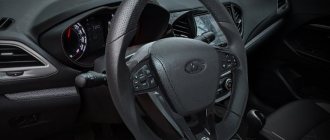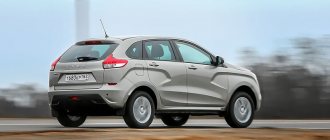The rise of a new “star” of the domestic automobile industry occurred at the end of the summer of 2014 at the Moscow International Motor Show - MIAS 2014. A completely new, practically conceptual car for the Russian consumer, the Lada Vesta was demonstrated according to all the rules of marketing PR. AvtoVAZ then made an excellent announcement for the Lada Vesta, which, according to analysts’ forecasts, should confidently join the market and find worthy recognition among car owners. Along with the Lada Vesta, a car with the almost forgotten name Datsun was presented to the public, but less modestly.
The Japanese brand, previously practically in the archives, has been revived thanks to the fact that the Japanese name Datsun can still remind Russian car owners of the famous Japanese quality. Currently, the Datsun brand is owned by the Nissan concern. At the last exhibition, the Datsun on-DO model seemed truly new and came to the Russian market somehow unusually quickly.
Immediately after the exhibition, AvtoVAZ plans decided to launch the new product into production. Despite the fact that the new Japanese car has its own unique appearance, it is still built on the basis of the VAZ platform and in the minds of managers in the new car market it will be an excellent idea against the backdrop of declining interest in the VAZ Granta and Kalina. As for the Lada Vesta, after the exhibition the car went for tests and AvtoVAZ planned to launch the new product only a year later. On September 25, 2015, serial production of the Lada Vesta started at the LADA Izhevsk plant and exactly a month later, on the night of November 24-25, mass car sales began.
Lada Vesta or Datsun
The rise of a new “star” of the domestic automobile industry occurred at the end of the summer of 2014 at the Moscow International Motor Show - MIAS 2014. A completely new, practically conceptual car for the Russian consumer, the Lada Vesta was demonstrated according to all the rules of marketing PR. AvtoVAZ then made an excellent announcement for the Lada Vesta, which, according to analysts’ forecasts, should confidently join the market and find worthy recognition among car owners. Along with the Lada Vesta, a car with the almost forgotten name Datsun was presented to the public, but less modestly.
The Japanese brand, previously practically in the archives, has been revived thanks to the fact that the Japanese name Datsun can still remind Russian car owners of the famous Japanese quality. Currently, the Datsun brand is owned by the Nissan concern. At the last exhibition, the Datsun on-DO model seemed truly new and came to the Russian market somehow unusually quickly.
Immediately after the exhibition, AvtoVAZ plans decided to launch the new product into production. Despite the fact that the new Japanese car has its own unique appearance, it is still built on the basis of the VAZ platform and in the minds of managers in the new car market it will be an excellent idea against the backdrop of declining interest in the VAZ Granta and Kalina. As for the Lada Vesta, after the exhibition the car went for tests and AvtoVAZ planned to launch the new product only in a year. On September 25, 2015, serial production of the Lada Vesta started at the LADA Izhevsk plant and exactly a month later, on the night of November 24-25, mass car sales began.
Not a luxury, but a means of transportation
After AvtoVAZ became part of the Renault-Nissan concern, an automatic transmission ceased to be a luxury: today you can become the owner of a new Lada with an automatic transmission by paying just over half a million rubles. The buyer will have to choose between two designs - the classic Japanese four-speed automatic transmission Jatco and the robotic five-speed transmission produced by AvtoVAZ in collaboration with the German ZF.
AutoMPS decided to evaluate both types of transmission from the consumer’s point of view and at the same time compare distant “relatives” - Lada Vesta (robotic gearbox with a single-plate clutch) and Datsun on-Do (Jatco automatic) in a comparative test.
Lada Vesta, whatever one may say, is currently the best model of AvtoVAZ. Modern long and most importantly wide chassis, beautiful design. Recently a station wagon and even a stylish Vesta SW Cross appeared.
In 2014, the then head of AvtoVAZ, Bu Inge Andersson, explained the emergence of a robotic transmission of his own design, among other things, by the desire to provide the client with the maximum range of products, but today the plant does not allow cars to be configured at the buyer’s discretion. Judge for yourself - modern Lada Vesta models and modifications, X-Ray) are offered (except for mechanics) only with a “robot”, and the appearance of a full-fledged “automatic” is expected no earlier than in 5 years.
The Lada on our test is in the beautiful red color of the factory name “Carnelian”. Vesta operating experience will allow you to draw certain conclusions, both on the safety of the car itself and on the reliability of the gearbox. Now a car in a comparable configuration costs 670 thousand rubles.
The Datsun tested is practically new; at a car dealership, a similar vehicle configuration will cost 570 thousand rubles. For this money, the buyer will receive an 8-valve 87-horsepower 1.6-liter engine (a 16-valve engine with an automatic transmission is not offered) and the most necessary options.
So who is more interesting than the Lada Vesta or the Datsun-ON-DO?
The exterior of the Lada Vesta is fully consistent with the Lada X-RAY concept developed back in 2012. The main features of this style are the side depressions on the sides of the car in the form of semi-ovals, and the front part of the car resembles an X sign, which is essentially not a completely new design solution. The headlights and, in general, the entire optics of the car have an aggressive look, angular shapes and lines clearly correspond to the new chosen style. Steve Mattin, the designer of AvtoVAZ, made the car truly attractive and promising.
This is not to say that the Japanese On-do car is simple in design; rather, it has its own characteristics and pleasant moments in style. Large optics, a wide and strong radiator grill, even in appearance, show a special breed of on-DO. The lower bumper of the car also looks solid and solid, with excellently placed fog lights that are clearly in their place. In general, it’s clear that the concept of the X style can be seen in these two models, but the smooth lines and refinements of the designers made both cars especially attractive.
The main difference between the two cars is certainly the price of the two new products. In 2015, the Datsun on-Do sedan will be supplied to the Russian market in three trim levels: Access, Trust and Dream. Accordingly, the Lada Vesta manufacturers also have three trim levels: Classic, Comfort, and Luxury. AvtoVAZ's pricing policy for the Lada Vesta car is the absence of budget promotion of the brand; on the contrary, on-Do is positioned for the Russian market as a reliable, budget, Japanese car.
The on-Do manufacturer equips the car with only one standard engine, which has long established itself as an “eight-valve” 1.6-liter engine; it fully complies with the requirements of the Euro-4 eco-standard. For a car of this class, this engine is quite sufficient; its efficiency and power are perfectly balanced for both the city and the countryside. The maximum power of the on-DO engine is 87 hp. With . at 5100 rpm. Acceleration time from zero to 100 km/h will take from 12.0 to 12.5 seconds, average fuel consumption in mixed mode does not exceed 8.0 liters of 95 gasoline. The maximum speed is 170 km/h.
Exterior
The appearance of both models is average. However, Priora looks more sharpened, and her image has more straight lines and angles. Convex head optics, a sloping hood, a neat radiator grille, a line running across the entire sidewall, an expressive rear end - all this has become familiar to the Lada over the years.
The Priora's appearance has more sporty notes.
The Datsun is made in a different manner, and in many ways it is copied from the Lada Granta. Its lines are smooth, there are no sharp transitions, bends or undercuts. The front of the on-Do sports a massive bumper and an impressive radiator grille. In profile, all lines are rounded, and the rear is highlighted by a large trunk lid.
Datsun defends the classic direction.
Comparison of two models
Most share the opinion that the Japanese product is significantly inferior to the Russian car in many respects. A comparison of Lada Vesta and Datsun On Do is presented below:
- The gasoline engines of both cars have a volume of 1.6 liters, but the internal combustion engine in the VAZ new product has a power of 106 horsepower, while the Japanese engine produces only 82 hp. With.
- Lada Vesta is slightly heavier than its opponent, but accelerates to 100 a second faster.
- The ground clearance of the Russian new product is 4 cm higher than the ground clearance of the Datsun On Do.
- The latter has wheels with a diameter of 14 inches; the R15 is installed on the Lada Vesta.
- O does not make any unpleasant sounds or squeaks when driving, but does note a slight howl in 2nd-3rd gear. The model also has good headlights.
What's under their hood?
Lada Vesta engineers plan to develop a 1.8-liter engine, but currently the car is being launched on the assembly line with an 8-valve engine with a capacity of 87 hp. With. Also in some trim levels it is possible to install a 16-valve 1.6-liter engine. With a power rating of 106 hp. The fast Lada Vesta, with a maximum speed of 185 km/h, will allow the car to accelerate to 100 km/h in 10.3 seconds.
Both cars have a nice and spacious interior made of quality materials. But it’s immediately clear that the interior of the Lada Vesta looks richer, even starting with the basic configuration. As a result of long-term work, auto engineers were able to improve the control and reliability of Vesta, so in comparison with the Japanese On-do car, Vesta is more practical and thorough. But do not forget the difference in cost of almost 100,000 rubles. At the same time, on-Do has its own modern equipment and good capacity.
In general, each of the cars presented in this short comparison is exceptionally good in its class and will certainly find its buyer.
Impressions of some owners
The Datsun's manual transmission may seem more dynamic, but the new chassis is much more comfortable. The operation of the Vesta engine is somewhat quieter than that of a Japanese foreign car. The relative advantages of the Datsun include the high-quality work of the glass closer and the appearance of the instrument model. Comparing prices, you come to the conclusion that an opponent of a VAZ car can be purchased for 100,000 rubles less than Vesta (440,000 versus 550,000). What to choose is up to the future owner to decide.
The world market knows examples when a cheaper and more accessible model won competition from more expensive cars. If a car shows reliability and stability, its sales may be higher. If you compare Lada Vesta and Datsun On Do, a potential buyer will find pros and cons, which will be subjective in nature, which plays an important role in choosing a vehicle.
General characteristics
The model was equipped with 1.6L VAZ engines:
- 8-valve - 82 hp,
- 8-valve with lightweight piston group - 87 hp.
- 16-valve with a lightweight piston group and a modified intake manifold - 106 hp.
As for the transmission, options with a classic 5-speed manual transmission were possible; a little later the Japanese 4-speed “automatic” Jatco was added to production. The 106-horsepower engine is only available as a manual transmission due to the fact that the automatic was not designed for that amount of horsepower.
Three configurations were presented: Access, Trust, Dream.
The following were already available as standard:
- Anti-lock braking system, ABS;
- Brake Assist, BAS;
- Electronic Brake Force Distribution, EBD;
- Driver airbag;
- Heated front seats;
- Electric power steering.
Dynamics
We go to the city - a place where cars with automatic transmissions mainly live. The first and most straightforward test is the traffic light race. Our rivals have engines of the same volume - 1.6 liters. But Datsun has an 8-valve engine and produces only 87 hp. Vesta has a 16-valve engine and 106 horses. However, the difference in torque reserve is not so great ( see characteristics at the end of the article ). Moreover, on the more modest Datsun it is achieved at lower speeds, which should help in the city. And, of course, He-Do is lighter than Vesta.
Despite the fact that the Datsun has almost 19 horsepower less, the claimed 0-100 km/h acceleration time for both cars is about the same. Regardless of the factory measurements, let's compare the starting acceleration of test rivals.
A parallel start from a standing start, and in the first fractions of a second the Datsun On Do is even slightly ahead. The automatic reacts more accurately to gas, while the clutch drive on the Lada Vesta is clearly delayed. But already in first gear, as it approaches the red zone, Vesta slightly pulls ahead. High power and close gears also have an effect.
When accelerating with two pedals, the starting jerk of both cars is identical, and during acceleration, neither of the sedans has an advantage. Equal performance between two cars always favors the less powerful one, and besides, the Japanese Datsun gearbox is famous for its indestructibility and can repeat similar accelerations again and again. For traffic light starts, Lada Vesta and Datsun On Do receive one point each.
- Datsun on-DO 2017-2018 video tests. Test drive Datsun it before
The score becomes 4:3, so far in favor of Lada Vesta.
Cons and pros
Among the advantages, car owners note:
- Strong chassis and reliable suspension;
- Economical. Mixed gasoline consumption for an 87 hp engine. — 7 liters per hundred.
- Large ground clearance;
- Spacious trunk of 530 liters;
- Cheap and accessible spare parts, almost everything comes from Granta;
- Japanese automatic transmission of good quality.
The disadvantages usually include:
- Poor sound insulation;
- Poor paintwork, the body is not galvanized - it rusts on chips;
- Gearbox noise. In 1st and 3rd gear the manual transmission hums;
- The high cost of some spare parts that do not match the Grant;
- Poor quality of interior finishing materials;
- Weak factory wheel bearings, change already at 30t.km;
- “Sailage” from a side wind when driving on a highway.
It turns out that there are more minuses than pluses. Let's look at the price.
Expert assessment of cars
Driver's workplace
The most comfortable seats are in Logan. The most amorphous ones are those of Granta. The Datsun is in the middle, but gets a low score for its lack of vertical seat adjustment. The steering columns of the test trio are adjustable only in height, but Logan has a wider range and a more successful steering wheel profile. But the Frenchman’s visibility is bad: it has the most massive A-pillars and the smallest exterior mirrors.
Logan is a leader in the quality of materials and level of performance, but the ergonomics are not without sin: the rear window switches live on the console, and the seat heating buttons are located at their base. The Granta's interior is simpler, but more comfortable. And the worst of all is Datsun: there are still a lot of fittings from early Kalinas, the USB slot is hidden in the glove compartment without backlighting. Logan has the most spacious back row. The most voluminous trunks are in Granta and on-DO.
Despite the noticeable dispersion in the passport data, the dynamic characteristics of the entire trio are close and generally sufficient. Except that the Renault automatic works a little rougher than competitors' gearboxes and more strongly provokes the engine into high urban fuel consumption. At the same time, Logan has more understandable brakes with a good feeling of the first grip (which the Lada and Datsun brakes are sorely lacking) and more “correct” information on the steering wheel.
None of the test participants can be called truly quiet, but Logan is still a little ahead: first of all, this concerns engine noise, and to a lesser extent - aerodynamic and road noise. The smooth ride of all test subjects is good: in adequate modes it is unlikely to be able to force the suspension to rebound. In terms of microclimate, there is parity: all are equipped with effective climate control and heated front seats.
Adaptation to Russia
The ground clearance of our clients is almost crossover. However, Logan's geometric off-road rating is lower: its front bumper is 45 mm closer to the asphalt than that of the Lada and Datsun - you need to be careful when parking. The terms of warranty service are the same for all three, but we add a point to Lada for the widest dealer network, and, on the contrary, we reduce it to Datsun. All models are equipped with a full-size spare wheel and “drink” AI-95.
Kar-index
takes into account operating costs over a mileage of 70,000 km: registration and inspection fees, transport tax, costs of compulsory motor insurance, fuel and scheduled maintenance, as well as losses on resale of the car.
Comparative review and test drive of these cars on video:
Found an error? Select it and press Ctrl+Enter..
Top materials
News
Lada Granta
In 2011, AvtoVAZ began production of the Granta, built on the basis of the already well-known Lada Kalina.
The model was intended to finally replace the entire “classic”, as well as the Lada “Samara” line and even the “Kalina” itself.
It was assumed that the new Granta should not differ much in price from its predecessors, but the difference was still felt. This was due to new comfort and equipment with modern systems.
The main component of the increase in price of the model was the introduction of a mandatory driver airbag in all trim levels and modification of engines for Euro-4. These are inevitable steps on the path to modernity.
General characteristics
There are several body styles: sedan, hatchback and sport. If everything is clear with the first two, then the Lada Granta Sport variation was new to the Russian buyer. The main differences were brake discs with an increased diameter for greater control over braking during sharp maneuvers, reduced by 20mm. ground clearance, stiffer shock absorbers and low-profile tires.
Variations of the 1.6l engine. larger volume than Datsun on-DO .
- 8-valve - 82 hp
- 8-valve with lightweight piston group - 87 hp.
- 16-valve with lightweight piston group - 98 hp.
- 16-valve with a lightweight piston group and a modified intake manifold - 106 hp.
- 16-valve with a lightweight piston group and a modified timing system - 118 hp. for the “Sport” package.
There are several trim levels: Classic, Standard, Comfort, Luxe. There are also subcategories that expand the range of options.
In basic versions:
- Anti-lock braking system, ABS;
- Brake Assist, BAS;
- Electronic Brake Force Distribution, EBD;
- Driver airbag;
- Electric power steering;
- On-board computer;
- Standard immobilizer;
- Air conditioner;
- Front electric windows.
But heated front seats are not included as standard.
Leather upholstery and cruise control are missing from either trim level, just like the Datsun on-DO.
Since September 2022, the updated second-generation Granta has been produced. The following body styles will be available: sedan, hatchback, liftback, station wagon. A robotic 5-speed gearbox will be added to the Japanese automatic transmission.
Comparing bodies
Here Priora is ahead. Of course, Datsun is not limited to any one body style, offering customers not only a sedan, but also a hatchback.
In the Datsun body range, classics take pride of place.
However, Lada boasts twice as many variations - a sedan, a hatchback with 4 or 2 doors, and also a station wagon.
And the youth direction is reflected in the Mi-Do hatchback.
Consequently, in the VAZ arsenal there are both classic and youth, as well as economic versions.
The sedan is just one of the Lada body options.
The hatchback looks very modern, especially the 2-door.
This body reflects the mood of the younger generation.
However, the standard hatch is no less popular.
A regular hatchback is more practical.
But the most “universal” is the Priora station wagon.
The Lada Priora station wagon has a spacious trunk.
Cons and pros
Pros according to reviews from car owners:
- Good, energy-intensive, indestructible suspension;
- Large trunk of 520 liters, but 10 less than the Datsun;
- Nice, warm stove;
- Cheap and available spare parts;
- Maintainability, any service will take on the job;
- Low fuel consumption, about 7l. per hundred for manual transmission and 87 hp;
- Large ground clearance, convenient for parking;
- Japanese automatic transmission of good quality, reliable;
The disadvantages include:
- Reverse gear on a manual transmission sometimes does not engage the first time; you need to press the clutch again;
- Poor sound insulation;
- Poor paintwork - rusts on chips;
- Weak wheel bearings from the factory;
- Cheap, squeaky plastic;
What to expect from Datsun and Granta on the secondary market
When selling used cars, sellers often act dishonestly, concealing accidents and other unpleasant moments. Let's check what remains in the shadows of Datsun and Granta.
We found several advertisements for the sale of cars and checked the cars by license plate number through the Autocode service.
The first car that came across turned out to be a “bouquet” of troubles.
Let's start with the fact that the car was in a serious accident in 2016. Although this is not reflected in the ad.
Judging by the insurance calculations, it is strongly in the front part. The insurance company calculated the cost of repairs at more than 84 thousand rubles.
The mileage in the advertisement is indicated as 82,000 km, although according to the diagnostic card, back in 2022 the mileage was recorded at 80,000 km, and in 2022 already 50,000 km. All this leads to suspicion.
The “icing on the cake” was that the car was registered as a taxi. This is dangerous for two reasons. First, taxis are often used by two drivers in shifts, mercilessly around the clock, which negatively affects the general condition of components and assemblies. Secondly, taxi passengers, like some taxi drivers, treat the interior carelessly. There is probably damage from cigarettes on the seats and carpet, as well as damaged interior plastic.
Let us now consider “Granta”. Maybe she'll be less secretive.
This car, judging by the Autocode report, is “clean”.
There is only one unpaid fine of 500 rubles. The amount is not large. But she will be asked to pay when re-registering the car to the new owner, if this is not indicated to the previous owner in time.
Cheap and reliable Russian-made cars are often used as taxis. Naturally, the owners try to hide this fact when selling. Who would want to buy for themselves a car in which several thousand people have already ridden?
Author: Maxim Golenetskikh
What do you think about Datsun on - DO and Lada Granta ? Leave your comments after the article.
Interior
The updated Priora looks very modern and attractive inside. The dashboard, designed in the style of infographics, immediately catches your eye. The center console is made in a stepped outline, freeing up space for a large display in the top versions.
The Priora salon was clearly a success for the designers.
The dashboard on the passenger side is sloping, and the transmission tunnel is slightly turned towards the driver. The ergonomics are well thought out - the keys are quite large and well located. The dashboard itself is made of black plastic with gray inserts.
Datsun's interior is more traditionally designed. The center console looks monolithic and is decorated with silver elements, and the controls on it are located conveniently and logically. Shallow wells in the tidy give the interior a sporty feel, and the readings are read instantly.
Just like in appearance, the Datsun is more conservative inside.
In general, the interior of both models is quite attractive, but the Priora’s is more modern.











